A variety of Chinese steamed buns, flower rolls (Hua Juan) are layered with a tasty scallion filling. Follow my quick & easy method to make some!

What are flower rolls
Flower rolls (knowns as Huā Juǎn/花卷 in Chinese) are a variety of Chinese steamed buns. Layered with a light oily filling, they often come with a savoury taste, but sweet versions exist too. Similar to Mantou/馒头 (plain steamed buns) flower rolls are made of leavened wheat flour dough and served as breakfast or as a staple for regular meals.
How to make the perfect dough
The dough for the flower rolls is based on my quick & easy recipe of Mantou which uses both yeast and baking powder as raising agents. For making 6 rolls, you will need:
- 250g all-purpose flour, plus extra for dusting
- 1 teaspoon dried active yeast
- ¾ teaspoon baking powder
- 1 teaspoon sugar
- 130ml lukewarm water
All-purpose flour works fine
What it comes to flour-based recipes, I’m often asked “What type of flour shall I use” or “Do I have to use special flour for dumplings/buns”. My answer to these questions is: the most accessible all-purpose flour works perfectly.
All-purpose flour (aka plain flour) usually has a medium level of gluten (10-11g protein per 100g flour) which produces a fluffy, yet a little chewy, texture. In some countries, eg. Canada or Switzerland, all-purpose flour has a higher gluten content. Add a little cornstarch (10%) to the flour if you prefer fluffier rolls.
In Chinese/Asian stores, you may find flour labelled as special flour for steamed buns/bao. It has a low gluten level thus produces fluffy buns. As it’s highly processed and bleached, the flower rolls made of this type of flour would look much whiter.
Rest the dough once only
Unlike the traditional way of making steamed buns, my dough recipe calls for both yeast and baking powder. This alteration largely reduces the dough resting time.
Once a smooth dough is formed, you can shape the flower rolls straight away. Then leave to rest for 30 minutes before cooking.
How to make a tasty filling
What makes flower rolls different from Plain Steamed Buns? It’s the tasty filling between each layer of dough. Like the popular Scallion Pancakes, my flower rolls are seasoned with similar ingredients: finely chopped scallions, ground spice (Chinese five-spice powder or ground Sichuan pepper), salt and a little oil.
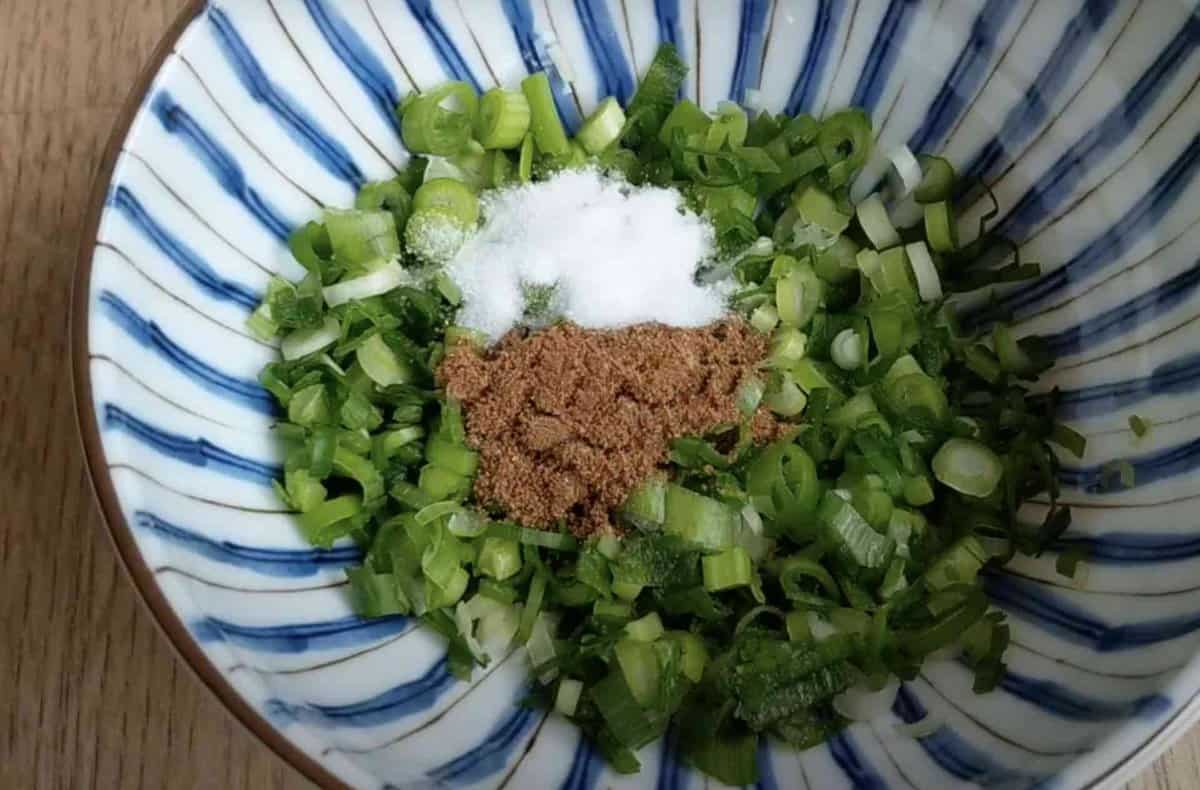
It’s fine to simply mix all four ingredients then brush onto the dough. However, I like adding one more step to make the filling even tastier: heat up the oil then pour over the scallions. The heat will release more aroma out of the scallions. Or, if you have a jar of Homemade Scallion Oil at hand, mix it with ground spice and salt, then brush onto the dough.
Don’t have either Chinese five-spice or Sichuan pepper? Use ground black pepper instead. Or, create your own combination of herbs & spices.
How to shape the rolls
There aren’t any set rules on how you should layer and shape flower rolls. As I’m quite obsessed with the appearance of my food, I’ve tried many different methods over the years. The particular one used in this recipe is neat, effective and creates a beautiful look.
It’s an easy method to master. The other day, my 7-year-old daughter watched me making flower rolls for filming the tutorial video. She quickly picked up the idea and shaped another batch of rolls on her own.
This is how I shape them step by step (please refer to the tutorial video):
1. Dust some flour over the worktop. Roll the dough into a thin, rectangle shape (about 20cm×30cm). Evenly coat the dough with the filling.

2. From the long side of the rectangle, fold the dough twice making it a three-layer strip. Then cut it into 12 pieces.
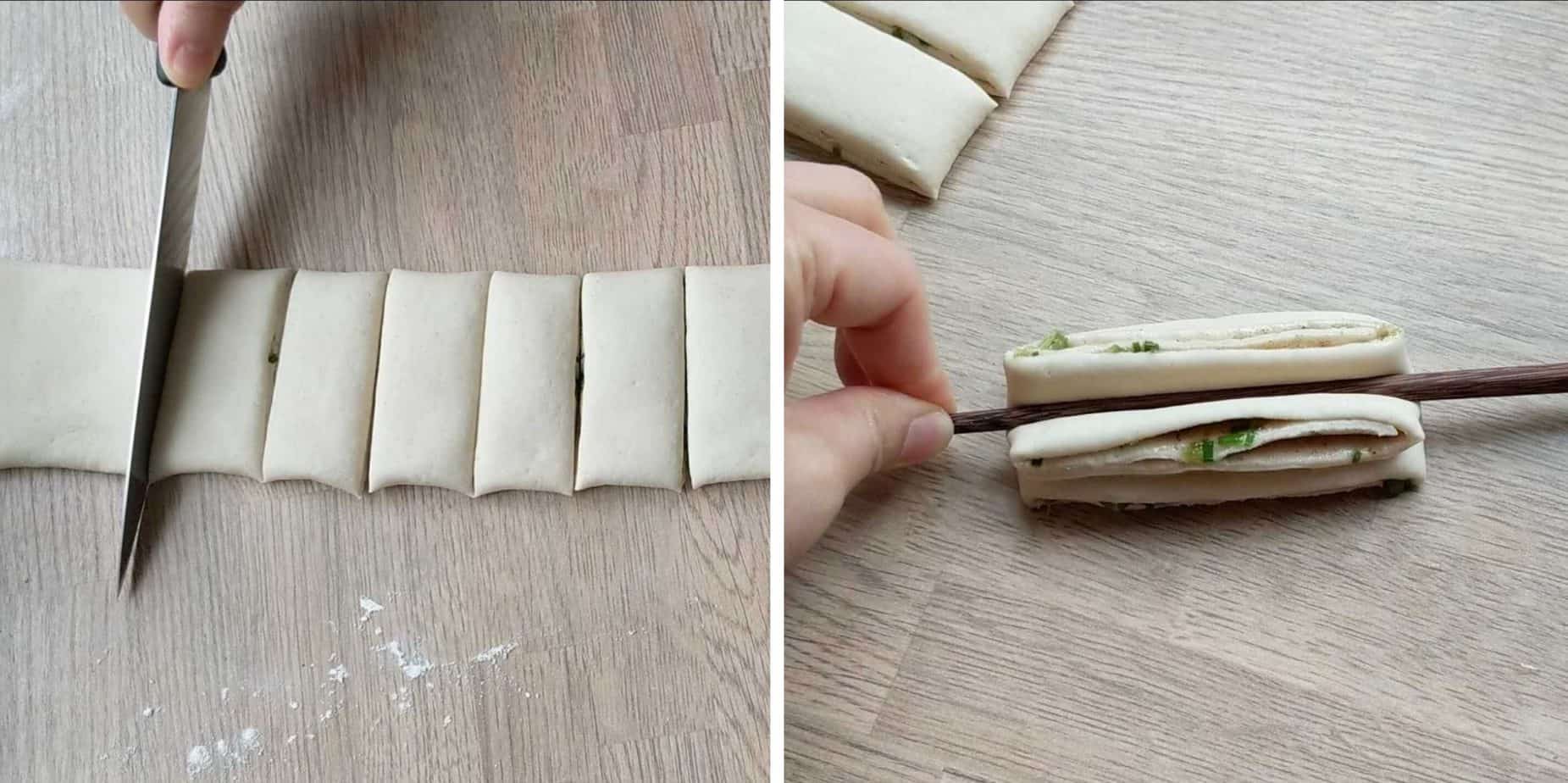
3. Stack up two pieces. Use a chopstick to press the middle line lengthways. Hold both ends then stretch.

4. Hang it over the chopstick. With one hand pinch and hold both ends. With the other hand twist the chopstick.
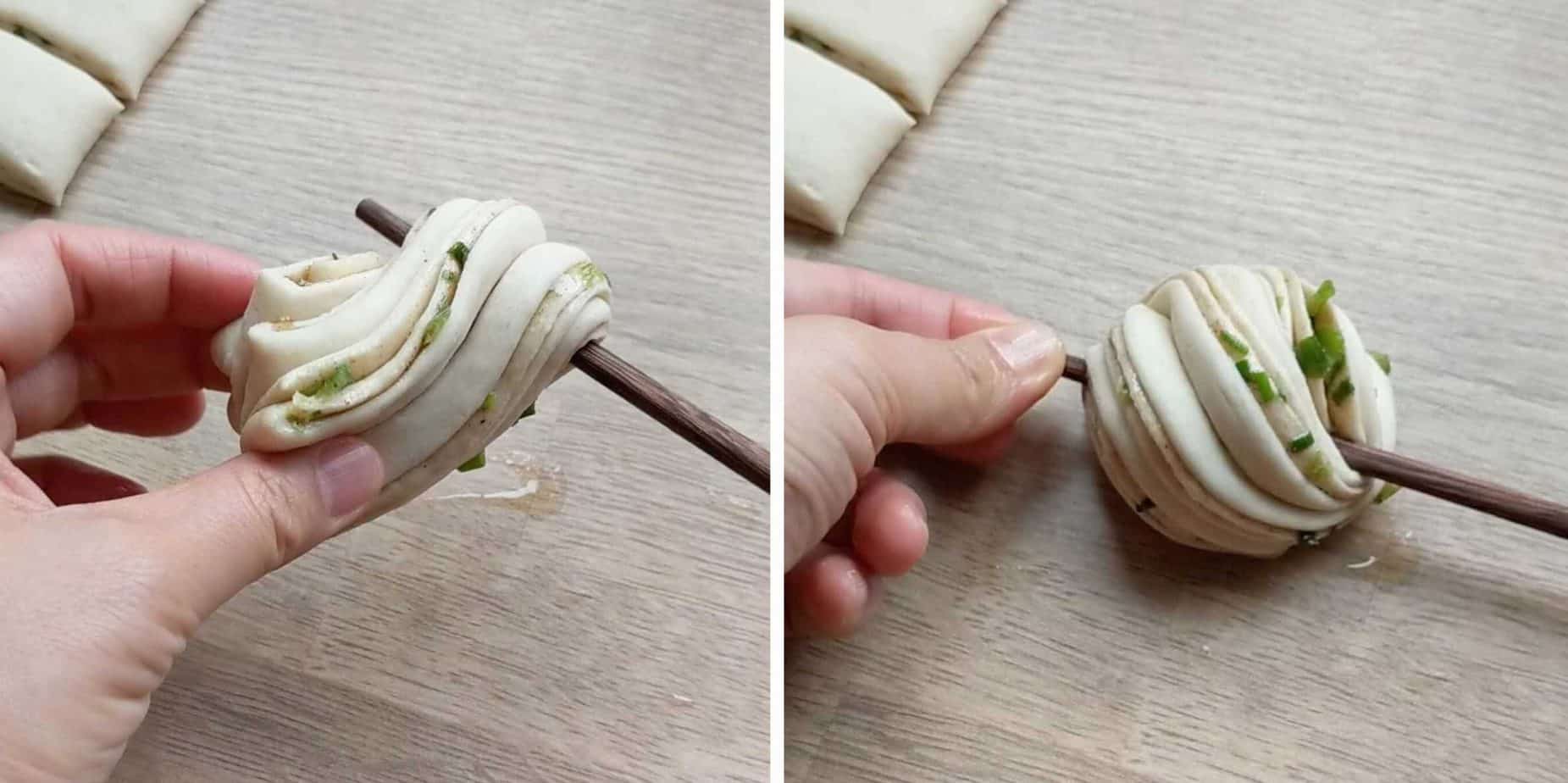
5. Put the roll on the worktop, press the chopstick then slide it out of the roll.
Two ways to cook flower rolls
Traditional method: steaming
As I mentioned above, flower rolls are a type of Chinese steamed bun. So they are usually cooked in a steamer basket. Here is the procedure:
Inspired by Pan-fried Pork Buns, I sometimes fry my flower rolls as I adore the golden, crispy crust. I highly recommend you try this method, especially if you don’t own a steamer.
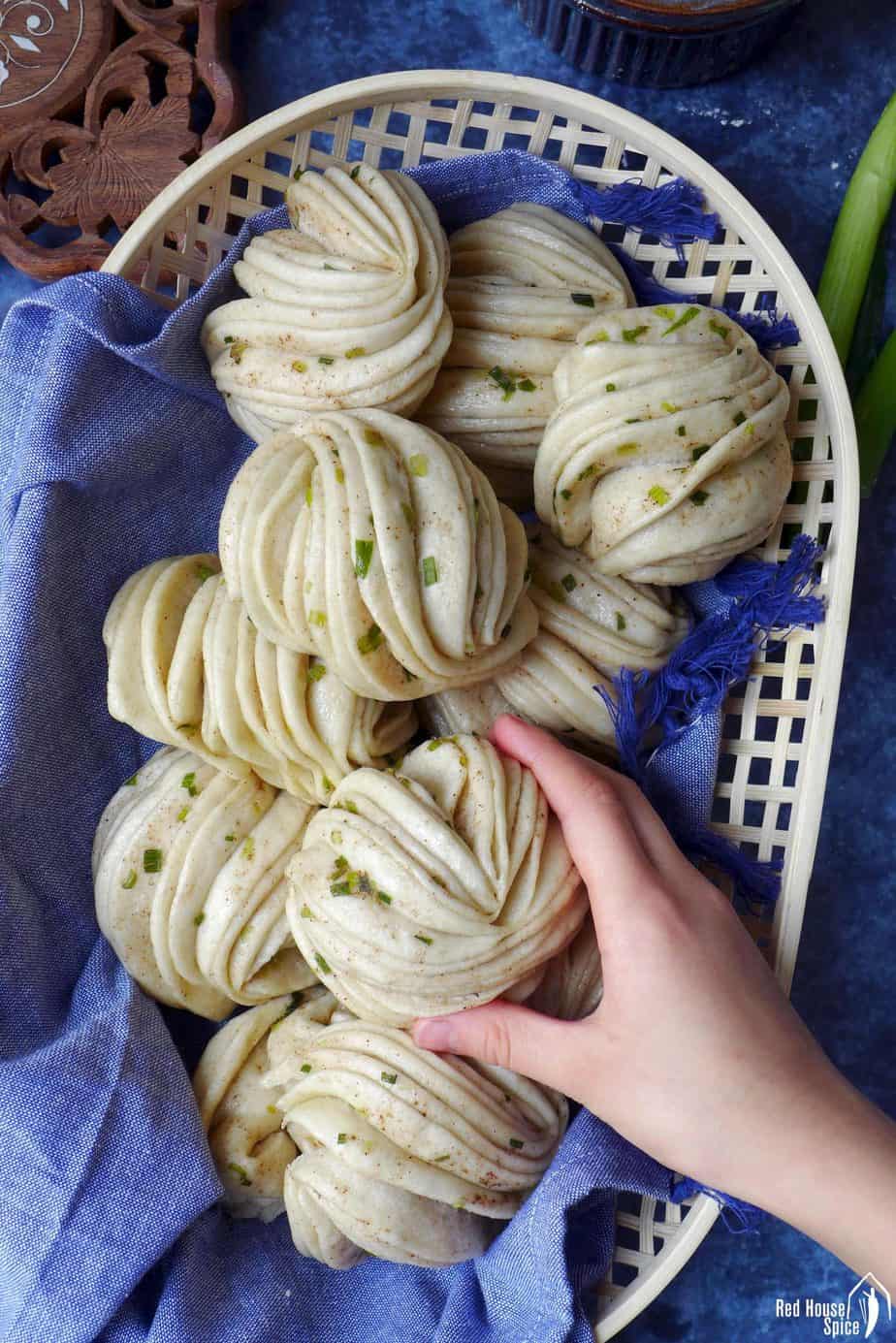
- Line the basket with a piece of steamer parchment paper, or brush a thin layer of oil if using a metal steamer. Then place flower rolls on top.
- Fill the steamer pot with cold water. Put in the basket with a lid. Start cooking over high heat.
- When the water boils, turn down the heat to medium-low. From this moment, count 10 minute cooking time.
Creative method: pan-frying
- Add oil to a frying pan over high heat. Place in the rolls leaving ample space in between.
- When the bottom of the rolls turn brown, pour in 200ml water. Cover with a lid.
- Uncover when the water has completely evaporated. Turn off the heat after 20 seconds or so.
How to store & reheat
My recipe makes 6 flower rolls which fit in a medium-sized bamboo steamer. If you have a multi-layer steamer at hand, I encourage you to cook a bigger batch at a time. They keep well in the freeze and can be reheated easily.
Once completely cooled, place the flower rolls in an airtight container/plastic bag. Keep in the fridge for up to 4 days or in the freezer for up to 2 months.
For reheating, simply steam fridge-kept rolls for 5 mins. If frozen, steam for 7 mins (no need to defrost beforehand).
What to serve with flower rolls
I enjoy flower rolls at breakfast, with a bowl of congee and some preserved vegetable or fermented bean curd. My children love eating them as an after school snack. Very often, we have them as the staple for dinner, along with several savoury dishes and probably a tasty soup too.
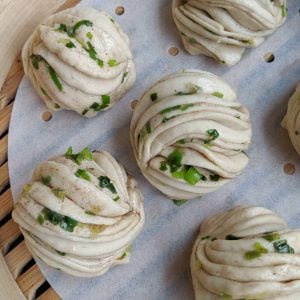
Chinese flower rolls (Hua Juan, 花卷)
Ingredients
For the dough
- 250 g all-purpose flour - plus extra for dusting
- 1 teaspoon dried active yeast
- ¾ teaspoon baking powder
- 1 teaspoon sugar
- 130 ml lukewarm water - see note 1
For the filling
- 2 tablespoon scallions, finely chopped
- ¼ teaspoon Chinese five-spice powder - or ground Sichuan pepper
- ¼ teaspoon salt
- 1 tablespoon cooking oil
If pan-frying, you also need
- 1 tablespoon cooking oil
Instructions
Prepare the dough
- IF KNEADING WITH A STAND MIXER: Mix flour, yeast, baking powder, sugar and water in the bowl. Knead on low speed until a very smooth dough forms (about 8 minutes).
- IF KNEADING BY HAND: Mix flour, yeast, baking powder and sugar. Add water gradually. Mix with chopsticks/spatula until no more loose flour can be seen. Combine and knead briefly into a dough. Leave to rest for 10 minutes (covered). Knead again until very smooth.
Mix the filling
- Put scallions, Chinese five-spice powder (or ground Sichuan pepper) & salt in a bowl.
- Heat up the oil then pour over the scallions. Mix well.
Shape the rolls
- Dust some flour over the worktop. Roll the dough into a thin, rectangle shape (about 20cm×30cm). Evenly coat the dough with the filling.
- From the long side of the rectangle, fold the dough twice making it a three-layer strip. Then cut it into 12 pieces.
- Stack up two pieces. Use a chopstick to press the middle line lengthways. Hold both ends and stretch.
- Hang it on the chopstick. With one hand pinch and hold two ends. With the other hand twist the chopstick.
- Put the roll on the worktop, press the chopstick then slice it out of the roll.
Rest the rolls
- Leave the rolls to rest for around 30 minutes. Well-rested buns should be slightly bigger, but not double the size (see note 2).
Cooking method 1: steaming
- Place the rolls in a steamer basket (line with steamer parchment paper or brush a thin layer of oil to avoid sticking). Make sure to leave ample space in between each roll.
- Fill the steamer pot with cold water. Start cooking over high heat. Turn down to medium-low once the water is at a full boil.
- Cook 10 mins from this moment. Serve warm.
Cooking method 2: pan-frying
- Add oil to a frying pan over high heat. Place the rolls into the pan leaving ample space in between.
- When the bottom of the rolls turn brown, pour in 200ml water (at room temperature). Cover with a lid.
- Uncover when the water has completely evaporated. Turn off the heat after 20 seconds or so.
Store the rolls
- Once completely cooled, place the rolls in an airtight container/plastic bag. Keep in the fridge for up to 4 days or in the freezer for up to 2 months.
Reheat the rolls
- Steam fridge-kept rolls for 5 mins. If frozen, steam for 7 mins (without defrosting).
Video
NOTES
NUTRITION
NUTRITION DISCLOSURE: Nutritional information on this website is provided as a courtesy to readers. It should be considered estimates. Please use your own brand nutritional values or your preferred nutrition calculator to double check against our estimates.


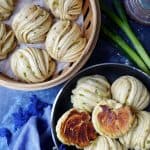

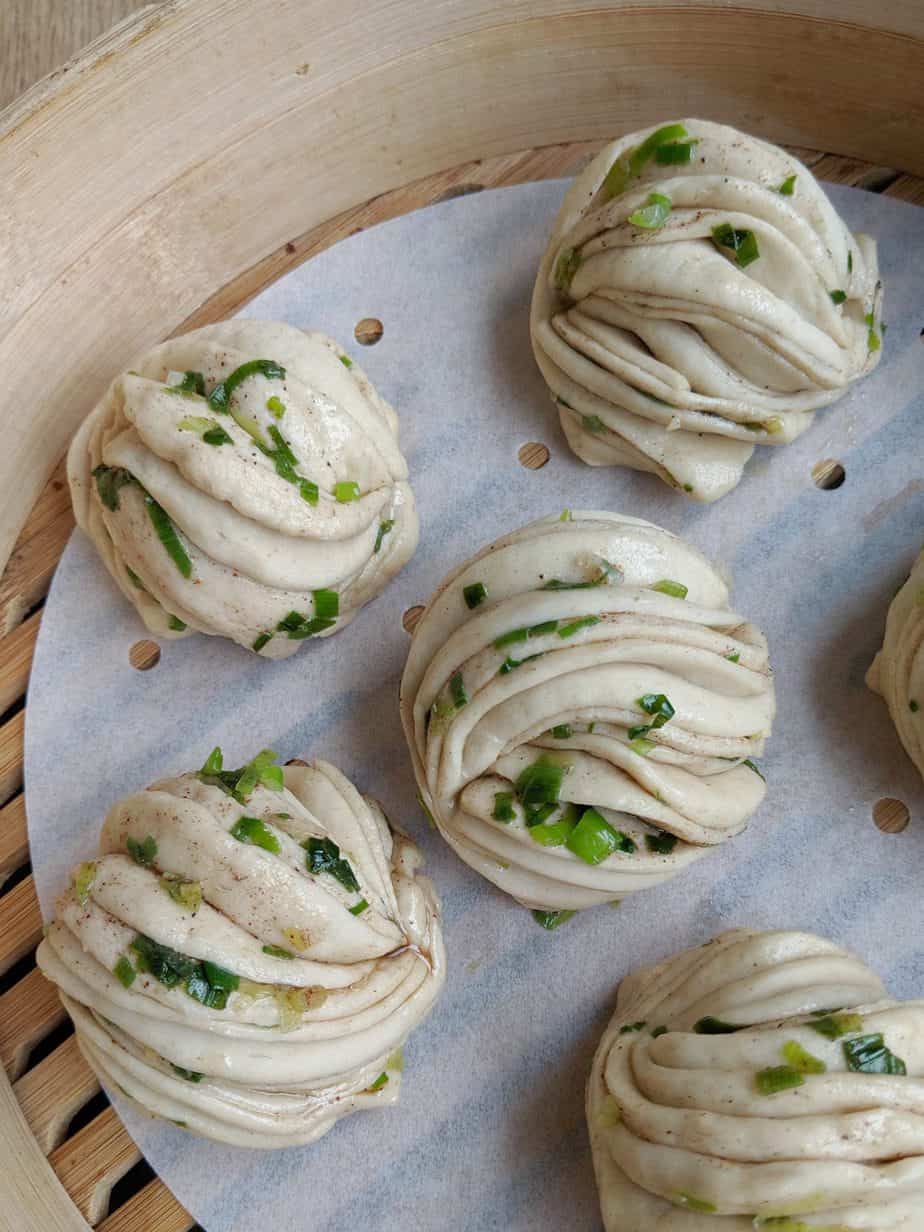
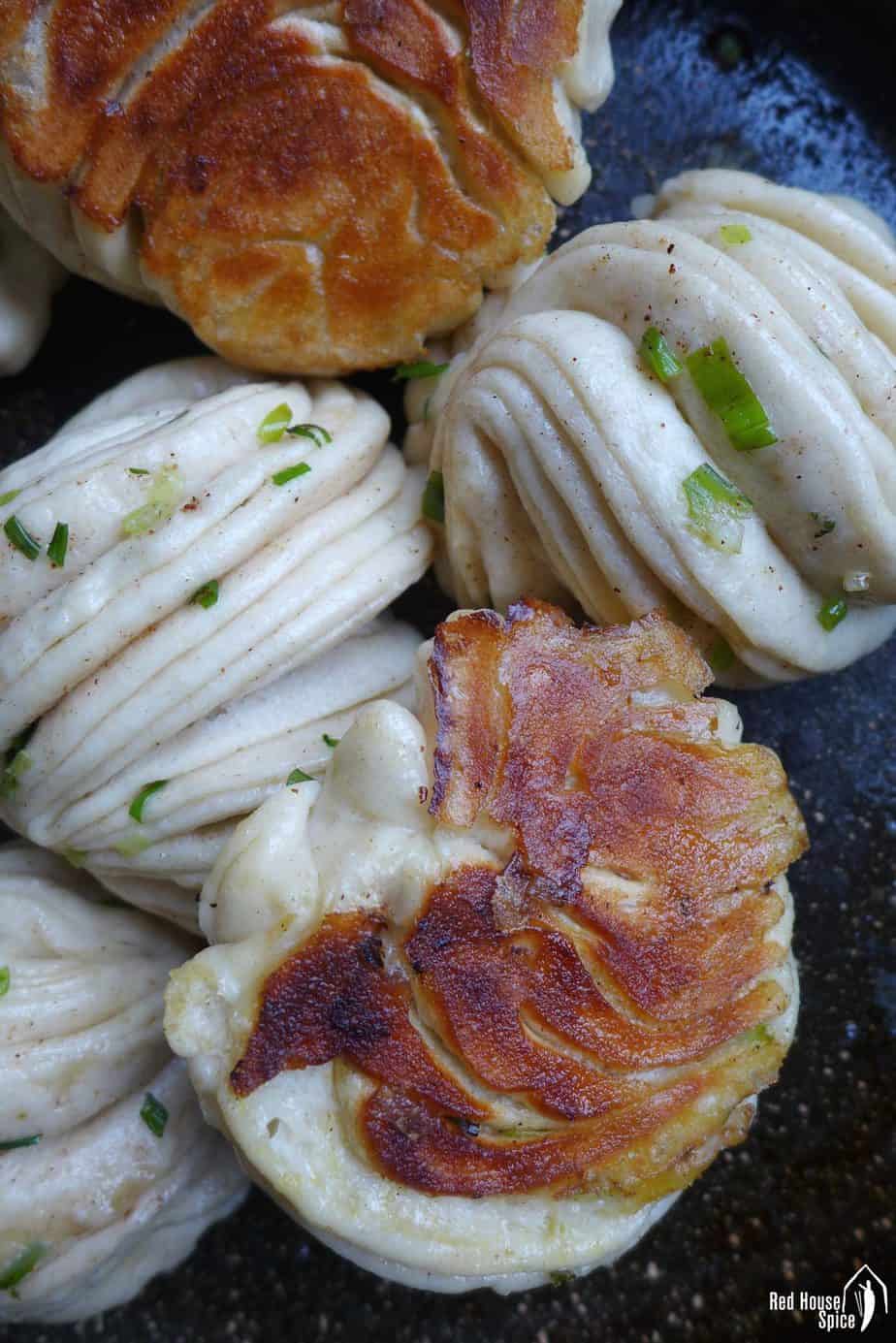
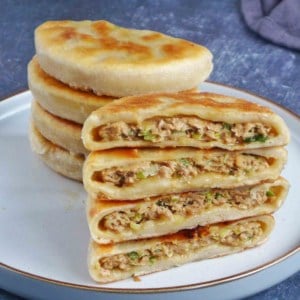
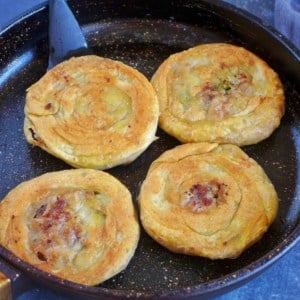
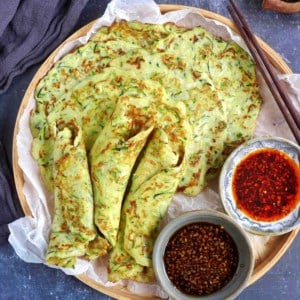
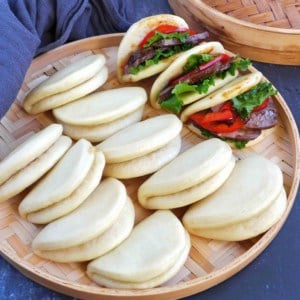
Great recipe, and great instruction in the video on how to make the flower shape! I could have made the dough a bit more elastic but it still turned out really well and tasty! I like having a go-to recipe like this since I am Chinese but where I live I can’t easily get access to these rolls in the grocery store. Homemade always tastes better anyway!
Totally agree that homemade tastes better. Glad you enjoyed my recipe Christine!
I made it again! This time, I made them smaller, so I didn’t stack the pieces, I just twisted each single piece and made 8 smaller rolls (though they still turn out pretty big) with the recipe for 6. Also, for some reason, this time my dough seized (I am using my stand mixer this time) but I added drops of water to loosen it. They are delish as usual!
As someone without a scale, I went by volume and had to add a lot more water. I used 2 cups roughly sifted flour and almost 150ml water. Otherwise the dough was much too dry, hard to knead and shape, and did not become very fluffy.
Other than that, I followed the recipe and it’s delicious! I used ground sichuan peppercorns in the filling and I really like the flavor.
So good!! I kneaded the dough for a bit longer than usual to get the gluten to develop, which was a very good move, because my buns came out tender, soft and so delicious and savory with the five spice and scallions. I also added some toasted sesame oil for extra flavor. Sandwiched a fried egg in a bun for dinner…omg it was so good 😋thanks for this recipe, the buns I made would make my grandma proud (she taught me her recipe as well)
I’m sure your grandma would be very proud of you! Flower rolls with fried eggs, yum!!
How can we freeze these buns? Should we steam them before and then freeze? Or should we freeze each flower dough?
This recipe is amazing!
Thank you!
Whoops! I just saw that it’s in the recipe! Thank you! I love these!
Freezing cooked buns is the best choice. Happy cooking!
Great recipe! I’ve used it several times and it’s always tasty. I did triple the scallions and Sichuan peppercorn for more flavor. Thank you for this easy beautiful bread!
Love your idea of adding more scallions and Sichuan pepper. Glad you liked my recipe!
I also tried them with chinese chives. Goooood